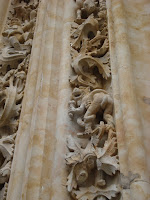Classes started again today, after my week of vacations. Although I was a little sad to be giving up most of my free time, I was rather happy to start back on what I came here to do. I may have been imagining it, but I felt more comfortable speaking up in class, and I think that it is due to the fact that I've been speaking a lot of Spanish over the past week. Also, and I don't know if this is a good thing or not, I have been mixing up my English and my Spanish. I am having trouble thinking in both languages, and I try to think primarily in Spanish, but every so often, (like when I am talking to my host mom) an English word slips in, and I feel absolutely ridiculous.
Over the break, I did a language exchange with a woman named Eva. She's a super nice, wonderful person (muy maja as a Spaniard would say) and we chatted about a lot of things, switching between English and Spanish. She told me about her experience when she was a young college student studying abroad in London. Apparently her host family was the stereotypical English family, very prim and proper and not very welcoming or emotional. She told me that she felt really alone while she was there, and thus knew what I was going through, being in a brand new place all by myself. She told me that if I'm ever feeling lonely or bored, that I could call her up and come join her wherever she was, whether she was with her kids or at her job (she leads tour groups through Segovia, so she knows a lot about Segovia history). I was so struck by her generosity and kindness! I feel so lucky to have met her, and I'm sure I will take her up on her offer.
One thing that is really different about Spanish culture is that as one walks down the street, one does not smile at people one does not know in passing. I am very much used to smiling at everyone I see, and I have had to work very hard to train my face to stay serious as I walk down the street. Of course when I see people I do know, I have to remember to smile, and that sometimes throws me off. I've noticed that when one does smile at strangers, they seem to think they might know you from somewhere and do a little double take to see if they recognize you. It's just a little something I need to keep working on.
 |
| Roasted Chestnuts (castañas asadas) |
 |
| In the nude |
I've been able to try a few more interesting things food wise since I last wrote. During this past week, there have been food and craft booths set up in the street facing the aqueduct and I got some roasted chestnuts (castañas asadas) at one of the booths. When I went to China on the study tour, we saw a man selling roasted chestnuts (at the Forbidden City? I can't remember now) but we didn't get any, and we never saw roasted chestnuts again, so I took this opportunity to try them. I had never had them before! At first I tried to eat them one-handed while walking to the Plaza Mayor, but that was a huge disaster, so I finally had to sit down and peel the shells off to eat them. It was an interesting sensation of the mouth; eating a warm and soft nut, with a really subtle flavor with staccatos from the blackened parts of the nut.
I also tried morcilla with my host family. Basically it is a black sausage made of rice and blood. I would love to say that I hated, that it was terrible, but that would be dishonest. Because, in reality, it was delicious. I think my host family expected me to not like it because I'm sure it puts off many Americans. But I think my past experience with bloody tofu prepared me to accept morcilla wholeheartedly (thought I won't be sad about becoming a vegetarian again upon returning home either).
This evening, I tried some membrillo. Membrillo is a jelly that is eaten in slices with bread and sometimes cheese. It was a really interesting contrast with the cheese (I'm not sure I liked it like that) but with just bread, one can taste the membrillo and it has a really unique flavor, sweet and bitter. It is made out of this fruit that my host mom showed me, and I have never seen anything like it before. It looks like a really big lumpy pear or apple and it is rock hard. Apparently people don't generally eat it raw (because it's so hard and acidic), but make it into this jam (which is called carne de membrillo). It was a little bit of an acquired taste, but on the second try, I found that I rather liked it.
This Friday, my good friend Amy (from UAA!), who is currently teaching English in Germany, will be coming to Segovia to visit. I'm very excited to see a fellow Alaskan and to explore Spain with her!
'Ta Luego!


























